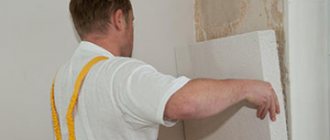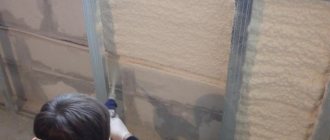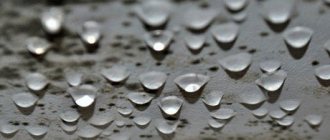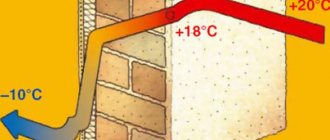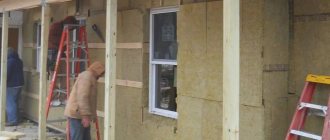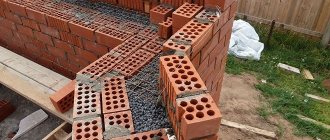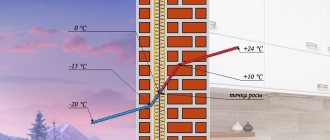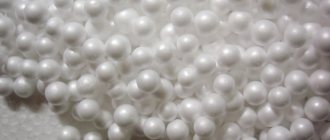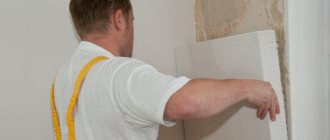Dew point
– the temperature at which water vapor in the air condenses into dew.
Condensate
is a product formed as a result of the transition of a liquid from a gaseous state to a liquid state.
Condensation on glass
The dew point depends on:
- Temperatures;
- Relative air humidity.
The higher the relative air humidity, the higher the dew point value, respectively, the lower the humidity, the lower it is.
The dew point cannot exceed the air temperature.
At 100% air humidity, the dew point will be equal to the air temperature.
What is dew point
The dew point is a certain limit of air temperature, below which the vapor contained in the air becomes saturated and turns into liquid.
The dew point is the place where cold air meets warm air, and the place where their interaction forms liquid in the form of condensation. Using the example of building structures, the dew point appears in the form of condensation on the windows. Always, when it gets cold outside, we see fogging and water droplets forming on previously dry window panes. This is the closest and most harmless manifestation of the dew point.
condensation on the window
In nature, the dew point appears in the form of drops of morning dew on plant leaves and other objects. It is formed as a result of the interaction of cold night air and warm morning air heated by the sun's rays.
manifestation of dew point condensation in nature
In the case of heated premises, the dew point is created artificially at any time of the day, under conditions of temperature below zero outside.
It is a completely different matter if the formation of such dew point condensation is detected on the inside of the wall of the house. Even a not very experienced builder will be concerned about the formation of excess liquid in a previously dry room. Since the consequences of such accumulations of moisture can be the most unfavorable. But the interior wall of a house is not the only destructive place where incorrect calculation of the dew point or its absence can manifest itself.
Incorrect calculation and location of the dew point for a home is the number one destructive enemy in construction. Which, from the inside, slowly but surely destroys any strong structure.
Additionally supplied
- No. 13-0054 Glycol filter. To purify the analyzed gas from glycol vapors. Particularly useful if the glycol condensation temperature is higher than the water dew point. May be included in the initial kit or added later.
- No. Р-0535 Tripod. Special lightweight and durable all-aluminum construction. Two-section stands, length 1.4 m when unfolded. Used as a stand for a dew point meter.
- No. Р-0536 Propane cylinder. 20 lb. cylinder with valve. Note: The cylinder is supplied empty.
- No. 13-0277 20 cubic foot cylinder filled with carbon dioxide for cooling and sealed. Equipped with valve and connecting fittings. Connection 1/4″ NPT Male.
Where should the dew point be?
The ideal place for the dew point to occur in a wall is the insulation located on the outside of the wall. The thickness of the insulation on the wall should be such that in the coldest time condensation does not move into the wall itself, or if it does, it will not be for a long time.
dew point in insulation
For the destructive consequences of the dew point being in the body of a load-bearing wall, see the article below.
Walls based on porous materials, such as foam and gas blocks, shell rock and similar materials, require a larger layer of insulation, since they absorb and retain moisture well. That is, even a short-term (several days) presence of dew point in a porous wall can have a destructive effect on the internal integrity. Therefore, so-called warm materials for masonry walls can only be effective in certain regions, with not the most frosty winters.
If, according to calculations, the dew point will periodically move into the wall of the house itself or there is a high probability of such a shift, then this fact should be taken into account when choosing material for laying walls. For such cases, wall materials with high density are well suited and can withstand a large number of freezing and thawing cycles without damage. With a high frost resistance coefficient. Such frost-resistant materials include brick and expanded clay concrete.
frost resistance indicators of the most common wall materials
General concepts
According to the definition of the meteorological dictionary, the dew point is the temperature to which the air must be cooled so that the water vapor contained in it reaches a state of saturation at constant pressure . In simpler words, this means that when the dew point is reached, water vapor begins to condense, that is, transition from a gaseous state to a liquid one. The most striking example of such a process is the appearance of dew drops on the grass on a cold summer morning due to the cooling of the thinnest ground layer of air. For this reason, this characteristic was called the dew point.
Dew point calculation online calculator
There are many online programs on the Internet - calculators, with which you can calculate the approximate location of the dew point in the wall. The program calculates the dew point based on a number of indicators that must be entered manually. This is information about the material from which it is planned to build the wall, the number of layers of the wall and their thickness, the air temperature inside and outside the building, air humidity. The online calculator is convenient for calculations. Together with digital calculations, you can see diagrams and graphs of the dew point movement depending on changes in air temperature. However, the calculation results for many calculators differ and how accurate the calculations are is unknown.
online calculator for determining dew point
Calculation of dew point using the device
The dew point can also be determined in real time using a special TV. This is an electronic device with a monitor that will display information about indoor humidity, air temperature and dew point. Such devices are relevant for measuring the dew point for an already erected and completed building structure. This device will not help in designing the thickness of walls and buildings.
dew point thermal imager
Main technical characteristics
| Dew point temperature range | -129…+93 °С |
| Accuracy | ±0.1 °C |
| Operating pressure | up to 5000 psig (34.6 MPa) |
| Connections | Inlet and outlet of analyzed gas 1/8″ NPT, refrigerant - 1/4″ pipe |
| Nutrition | rechargeable batteries, charger with 115 V or 220 V power supply |
| dimensions | 355×200×406 mm |
| Weight | 11 kg |
Damage to dew point for house walls
We figured out that the dew point can be located in three different parts of the wall:
- in external wall insulation
- in the wall, closer to the outside
- in the wall, closer to the inside
In each of the listed places, the dew point will manifest itself differently. If in one place it is harmless, then inside the house or in the wall it will have certain destructive consequences on the integrity of the wall. Below, we will analyze the behavior of the dew point in each of the listed places.
Dew point in external insulation
This is the most harmless dew point for your home. In this case:
- When the dew point occurs, condensation forms directly in the insulation itself.
- The insulation is not hygroscopic, therefore moisture is not retained in the wall structure and evaporates when the air temperature changes.
- Due to the vapor barrier properties of the insulation, the moisture that is formed when condensation evaporates goes outside and does not interact with the wall of the house.
- The walls of the house are dry throughout the year, both from the outside and from the inside
- The walls retain their strength and integrity for many decades
insulation on the outside
Dew point in the wall of the house, closer to the outside
- The behavior of a wall largely depends on the material from which it is made. Walls made of dense and heavy building materials such as brick, expanded clay concrete, stone, and wood can withstand dew point better. Because they are less susceptible to destruction and have a higher frost resistance coefficient.
- The walls of houses built from porous materials that absorb moisture well and allow steam to pass through. Such as foam blocks, gas blocks and similar materials, the effect of the dew point should be minimally short.
destruction of a wall due to moisture
- When condensation occurs inside the wall, the wall material becomes saturated with liquid. When the air temperature subsequently drops below zero, the accumulated liquid freezes and increases in volume. An increase in the volume of liquid destroys any wall material from the inside. This leads to the formation of both small and large cracks in the wall structure. The walls crumble and finally lose their strength.
- If the wall, in which the dew point is inside and is insulated from the outside, then the insulation will not prevent the accumulated moisture from escaping outside. Therefore, all the liquid will accumulate on the surface, between the insulation and the wall. This entails the formation of mold and mildew, with all the ensuing consequences that are harmful both to the building and to human health.
- If the wall of the house is not insulated from the outside, then the liquid will come out as the air temperature rises, but this will not protect the wall from internal destruction after the water freezes. We can observe similar evaporation of liquid from a damp wall in the form of a white coating on brick walls.
release of moisture from a brick wall in the form of a white coating
Dew point in the wall of the house, closer to the inner surface
It occurs when steam passes through the middle of the wall thickness and condensation begins to form closer to the surface of the wall, which is located inside the house.
Consequences of dew point for the interior decoration of the house:
- The masonry, saturated with moisture, begins to release liquid in the form of water droplets on the inner wall and into the house.
- A wet wall surface destroys the interior decoration of the room: putty, wallpaper and other finishing materials.
- Mold and mildew form on the walls and in the corners, which will be very difficult to get rid of.
- An unpleasant, shabby smell of decomposition appears in the house, which is harmful to health.
- The overall heat temperature in the house decreases.
mold on the wall inside the house
The most destructive and harmful consequences for the house is when the dew point is closer to the inner surface of the wall.
Dew point is an important parameter that should be taken into account when designing and constructing walls, roofs and the construction of the entire house. Failure to comply with it can lead to irreversible and critical consequences for the entire building.
Areas of application
There are many areas that take this temperature into account. One of the areas is aviation. During aircraft operation, condensation may form on some of its parts and freeze. This leads to freezing of the engine, metal structures of the flying vehicle and its breakdown.
In forestry, fire conservationists use dew point to calculate fire hazard class.
Experts calculate the likelihood of forest fires and develop protective measures.
Most often, determining the point is necessary in construction and agriculture.
Video: Dew point - insulating the house wisely
Construction
In construction, this value is determined when insulating the facades of buildings and private buildings. If you do not take into account the indicator or calculate it incorrectly, due to settling moisture, the wall finishing material will deteriorate or pathogenic flora and mold will appear.
Agriculture
In agriculture, experts determine the likelihood of damage to crops due to weather conditions, knowing the point and atmospheric humidity.
When cultivating new plants, breeders try to create varieties that condense moisture on the vegetative parts. Such plantings can exist with little precipitation.

